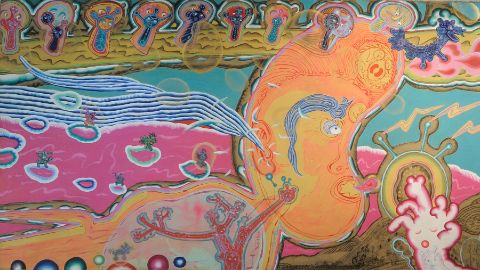Li Jiun-Yang

Detail
This large-scale canvas is representative of Li Jiun-Yang’s distinctive practice and engagement with traditional Taiwanese art forms, diverse religious representations, and vernacular culture on the island. The son of a movie poster painter, Li has also worked on movie posters, as well as temple paintings, calligraphy, Taiwanese glove puppets, and multimedia installations. Hailing from southern Taiwan, a distinctive cultural environment influenced by Taiwanese Indigenous people and Hoklo (descendants of the first Chinese migrants on the island arriving from the seventeenth century onwards and speaking the Minnan variety of Chinese languages), Li promotes a Taiwanese identity distinct from the Chinese Nationalist idea that sees Taiwan as part of a homogeneous Chinese cultural world. In the first centuries of Chinese migration to the island, both religious and political life revolved around vernacular temples, which were connected in horizontal structures—a system that provided forms of organization that eluded centralized political control. The world inhabiting Li’s canvas is a reflection of both the characters and the general spirit of boundless imagination born in those centuries of parallel political modes in Taiwan, prior to Japanese occupation. With the current spectre of imperialist Chinese takeover looming over the island, that idealized moment of local political imagination is being revisited in the public sphere.
Work in the exhibition: Fairy-Fairy-Fairy 35 (2011), painting, acrylic on canvas, 509 × 144 cm. Courtesy of the artist